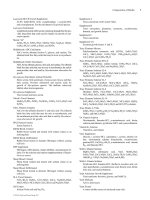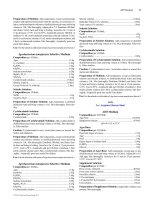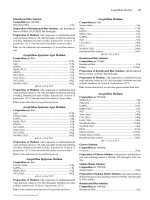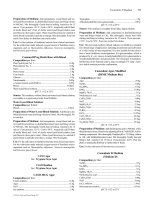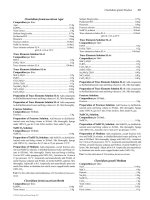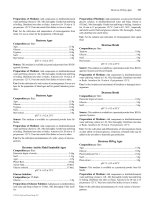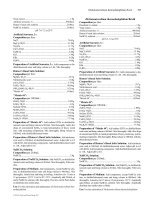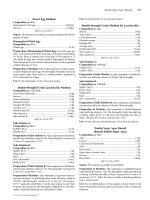Handbook of Small Electric Motors MAZ Part 2 docx
Bạn đang xem bản rút gọn của tài liệu. Xem và tải ngay bản đầy đủ của tài liệu tại đây (139.82 KB, 28 trang )
INDEX
I.1
Abbe error:
defined, 10.23
and Inductosyns, 10.36
and linear encoders, 10.25
Absolute count stacking, 3.38–3.39
Absolute encoders, 10.19–10.22
AC. See AC induction motors;AC series
motors;Alternating current;Syn-
chronous motors
Acceleration:
determining, 8.4–8.9
testing, 9.2–9.5
theoretical, 10.139
unit conversions, 1.5, 1.6
Accucore, 2.52
Accuracy,10.1–10.2
absolute encoder, 10.25
incremental encoder, 10.15–10.16
AC induction motors:
overview, 6.1–6.5
permanent-split-capacitor (PSC),
performance, 6.61–6.72
polyphase, performance, 6.93–6.102
shaded-pole, performance, 6.72–6.93
single-phase, performance, 6.45–6.61
single-phase, theory, 6.5–6.38
stator and coil assemblies, 6.1–6.2
testing, 9.5–9.9, 9.44–9.47
three-phase, theory, 6.38–6.44
typical applications, 8.34
windings, 6.2–6.5
Acrylics, as motor adhesives, 3.116,
3.122
AC series motors. See also AC induc-
tion motors
performance, 4.116–4.130
theory, 4.17–4.23
Actuators:
applying force and energy equations
to, 1.15–1.20
magnetizing sources for, 1.33–1.35
moving-coil, 1.40–1.41, 1.83–1.88
reluctance, 1.35–1.43, 1.78–1.82
ADA Smart Distributed System, 10.50
Adhesives, used in motor manufactur-
ing:
applications for, 3.117–3.123
chemistries of, 3.115–3.117
dispensing equipment, 3.123
joint design, 3.114–3.115
for magnets, 2.87, 3.122–3.123
overview, 3.109–3.114
safety factors, 3.124
testing of, 9.42–9.43
Advanced Research Project Adminis-
tration (ARPA),10.48–10.49
AEG, and PROFIBUS, 10.50
Aging (carbon-induced), defined, 2.44
Air flux, defined, 1.44
Air gap:
in BLDC motors, 5.40
controlling, 3.21–3.22
geometry, 4.75–4.84
linear equations, 1.33–1.43
magnetic coenergy in, 1.18–1.20
and mmf in dc series motors,
4.5–4.10, 4.117–4.119, 4.122–4.126
and mmf in PMDC motors, 4.27–4.32
and mmf in universal ac motors,
4.122–4.126
in permanent-magnet versus induc-
tion motors, 3.25
permeance, 1.21–1.32
predicting, 4.97–4.106
Air gap (Cont.):
in step motors, 5.55, 5.69
in switched-reluctance motors, 5.100
in VR step motors, 5.55
AISI, steel grade standards, 2.4
Allegheny-Teledyne Company:
on magnetic test methods, 2.71n
representative magnetic curves,
2.25–2.30
Allegro Microsystems, Inc.:
control circuits, 10.97
and current regulation, 10.90
Darlington arrays, 10.75
Hall devices, 10.93
H bridges, 10.88
smart IC controls, 10.7
Allen-Bradley, 10.50
Alnico, 2.90
demagnetization curves for,
2.103–2.107
density of, 5.21, 5.69
and eddy current effect, 3.143
in hybrid step motors, 5.76
leakage flux paths and, 1.30–1.31
and PMDC motors, 4.36–4.37
properties of, 1.49, 2.84, 2.87–2.89
typical magnetizing forces for, 3.125,
3.142
Alpha pattern winding, 4.162, 4.169
Alternating current. See also AC induc-
tion motors;AC series motors; Syn-
chronous motors
coil design, 1.72–1.73, 1.76–1.77
dynamic analysis, 1.80–1.81, 1.85–1.88
magnetic properties, 2.53–2.56
magnetic test methods, 2.74–2.80
motor manufacturing process flow,
3.1–3.2
in powder metallurgy applications,
2.65–2.71
Aluminum:
alloys, 2.87
coating, 2.86
coefficient of thermal expansion, 3.20
in end frame construction, 3.4
in housing construction, 3.10–3.12
in stator assembly processing, 3.21
Aluminum (Cont.):
thermal conductivity value, 8.16
thermal properties of, 8.19
American Bearing Manufacturers
Association (ABMA):
load ratings for bearings, 3.66–3.67
reliability ratings for bearings,
3.65–3.66
American Hoffman Corporation,
3.87n
American Society for Testing and Mate-
rials (ASTM):
ac test methods, 2.74–2.76
dc test methods, 2.72, 2.73
magnetic test methods, 2.71–2.78
P/M-related standards, 2.61
sample B-H magnetization loops,
2.6–2.7
steel grade specs, 2.4
American Wire Gauge (AWG):
and coil design, 1.69–1.77
and lamination design, 3.28
in stator winding design, 5.33–5.35
and wire properties, 2.179–2.183
and wire sizes, 2.176–2.177
Ampere’s law:
in determining armature mmf, 4.5,
4.28
and PMDC motors, 4.38
Amplitude modulation (AM), defined,
10.10
Anaerobic adhesives, defined,
3.115–3.116
Analog Devices, 10.40, 10.45–10.46
Anchored lead loops, 4.157
Ancorsteel:
magnetic characteristics of, 2.66–2.67
permeability of, 2.63–2.64
saturation induction for, 2.62
Anderson, Larry C., 3.87n
Angle of misalignment, defined, 3.58
Angular measurement device, 10.9
Anisotropic material, defined, 2.87
Annealing, lamination, 2.6–2.46
Antiferromagnetism, defined, 1.63
Antilock brake wheel sensors, materials
used for, 2.62
I.2 INDEX
Anunciada,V.:
and clocked PWM, 10.115
and dual-current-mode PWM, 10.116
and voltage PWM, 10.113
Applications, motor:
for ac motors, 8.34
current density and, 8.9–8.10
for dc motors, 8.33
electromagnetic interference (EMI),
controlling, 8.32–8.38
and environmental standards,
10.4–10.7
requirements for, 8.1–8.4
thermal analysis and, 8.10–8.32
velocity profiles, determining, 8.4–8.9
Arcing, minimizing, 4.9–4.10, 4.31–4.32
Armature:
balancing, 3.87–3.98, 4.61
conductors, 4.57–4.61
force, determining, 1.15–1.20
four-pole, 4.165–4.181
geometry, in PMCD motors,
4.106–4.108
geometry, in universal motors,
4.48–4.54
magnetic circuits, 4.54–4.57
manufacturing/assembly, 3.22
mmf in dc series motors, 4.5–4.10
mmf in PMDC motors, 4.27–4.42
reactances, 4.82–4.84
varnishing of, 3.106
winding, theory and practice,
4.140–4.181
yoke, defined, 4.54
Armco:
product properties, 1.46
and steel grade designations, 2.4
Arnold Engineering Company, typical
magnetic curves, 2.102–2.133
Arnox, demagnetization curves for,
2.108–2.112
ARPA, 10.48–10.49
ASIC technology, and environmental
concerns, 10.6
ASTM. See American Society for Test-
ing and Materials (ASTM)
Automated testing, 9.43–9.47
Avogadro’s number, 1.63
AWG. See American Wire Gauge
(AWG)
Axial air gap motor, 5.9–5.11
Axial field, 1.65–1.66
Axial play, defined, 3.56–3.57
Axis SPA, 3.79n
Babbit, as bearing material, 3.72
Back electromotive force (emf):
constant, 4.115
defined, 1.80–1.81, 1.86
in three-phase motors, 10.112–10.113
trapezoidal versus sinusoidal drives,
10.122–10.124
in two-phase motors, 10.98–10.99,
10.101–10.102
Back iron, 5.13, 5.40
Back-iron thickness, defined, 3.16
Balancing:
PSC motor, 6.69–6.72
rotor assembly, 3.19, 3.87–3.98
Ball bearing analysis, 9.17–9.23
Ball bearings. See Bearings
Band, Robert, 9.43n
Bank, John S., 3.99n
Barium ferrite, as magnet material, 2.90
Bearings:
assembly and fitting of, 3.69–3.72
ball-type, 3.47–3.48, 3.51–3.55
components, 3.51–3.55
geometry of, 3.55–3.58
grease tests, 9.41
lubricants for, 3.51, 3.61–3.66,
3.73–3.79
materials used for, 3.58–3.61
overview, 3.46–3.48
preloading of, 3.67–3.69
selection of, 3.49–3.51
sleeve-type, 3.72–3.79
static capacity of, 3.66–3.67
Bell, F.W. (Hall device manufacturer),
10.93
B-H curve, 1.8–1.9, 2.81–2.84
and Hall devices, 10.32–10.34
and PMDC motors, 4.38, 4.42,
4.110–4.112
INDEX I.3
B-H curve (Cont.):
and series dc and ac motors, 4.122
and shaded-pole motor, 6.81–6.82
Bifilar winding, 5.49, 5.104
Biot-Savart law, 1.65–1.66
Bipolar motors, 5.49, 5.86–5.87,
10.75–10.79
Bipolar slide-by Hall sensor, 10.30,
10.33
Bitter, Francis, 2.98
Bitter coil, 2.98
Blade gap, in lamination design,
3.30–3.31
BLDC motors. See Brushless dc
(BLDC) motors
Blue coating (bluing), 2.45
Bode plot, 9.31, 9.35
Bohr magneton, 1.5, 1.62–1.63
Bonded cores, 3.26
Bonding agents, 2.87, 3.121–3.123. See
also Adhesives
Boron, properties of, 1.49
Bosch (as developer of CAN), 10.50
Boundary element analysis, 5.65
Boyes, Geoffrey S., 10.46
Bozorth, R. M., 1.56
Brackets. See End frames
Breakdown torque, defined, 10.52
Brinell hardness values, 1.43
Brod, D. M., 10.113
Bronze, in sleeve bearings, 3.72
Brown,Warren, 3.42n
Brushes:
arcing, 4.9–4.10, 4.31–4.32
contact loss, 4.16–4.17, 4.44–4.46
current density calculations,
4.115
effect on polarity, 4.158
in four-pole armatures, 4.170
holders, 3.99–3.103
selection, 4.84–4.87, 4.163–4.165
as source of heat loss, 8.12, 8.14
Brushless dc (BLDC) motors:
applications, 10.7–10.9
configuration, 5.4–5.13
design, 5.36–5.46
drive schemes, 10.97–10.119
Brushless dc (BLDC) motors (Cont.):
overview, 5.1–5.3
performance characteristics,
10.122–10.140
sizing and shaping, 5.11–5.22
stator winding design, 5.22–5.36
Bularzik, Joseph H., 2.51n
Bureau of Standards, and dc test meth-
ods, 2.74
Cages, bearing, 3.49, 3.51, 3.59–3.61
Caine, Peter, 3.103n
Campbell, Peter, 10.28
Canadian Standards Association, and
insulation requirements, 2.167
Capacitance. See also Capacitive-
discharge magnetizers
during magnetization, 2.95, 3.144
thermal, 8.13–8.16, 8.31–8.32
Capacitive-discharge magnetizers,
2.93–2.97, 3.131–3.133
CDM systems, 3.138–3.142,
3.145–3.146
fixture design for, 3.133–3.137
process of magnetizing, 3.142–3.147
Capacitor-start motors:
performance calculations, 6.45–6.59,
6.60–6.61
typical applications, 8.34
Carbon contamination:
annealing as antidote to, 2.44
from brush dust, 4.87
Carbonitriding, defined, 3.14
Carburizing process, 3.14
Carpenter, soft magnetic material prop-
erties, 1.46
Carriage, defined, 10.23
Carter’s coefficient:
calculating, 4.75
and magnetic air gap length,
4.99–4.100, 6.78
Cartridge-style brush holders, 3.100
Case hardening, explained, 3.14–3.15
Cast iron:
coefficient of thermal expansion,
3.20
in end frame construction, 3.4
I.4 INDEX
Cast iron (Cont.):
in housing construction, 3.10–3.11
in stator assembly processing, 3.21
CDM systems. See Capacitive-discharge
magnetizers
CDX, defined, 10.37
CE mark, European Community, 10.6
CEN, and EMI regulation, 8.32–8.35
Centimeter, gram, second. See CGS sys-
tem of units
Centripetal force, and rotor balancing,
3.91
Ceramic materials, 2.90
B-H curves and, 2.83–2.85
and PMDC motors, 4.36–4.37
properties of, 1.49, 2.87–2.89
thermal conductivity value, 8.16
typical magnetizing forces for, 3.125
C-frame shaded-pole motors, 6.73, 6.74,
6.78, 6.80, 6.85–6.86
CGS system of units, 1.1–1.3, 2.5, 5.88
Chai, H. P., 5.77
Chang, S. S. L., 6.73, 6.83
Chillers, for magnetizing process,
2.98–2.99
Choppers, in controlling current,
10.84–10.86
Chord factor, 5.32–5.33
Chrome steel, in bearing manufacture,
3.49, 3.58–3.59, 3.65
CIP gaskets, 3.120–3.121
Circular-mil slot-fill percentages, 3.32
Clean-sheet methodology, and BLDC
motor design, 5.45–5.46
Cleated cores, 3.27
Cleavage stress, defined, 3.115
Clifton Precision, 10.43
Clocked PWM, 10.114–10.116
Closed-loop control, 10.69–10.70
Closed-pocket retainers, 3.59
CNC machines:
in end frame manufacturing, 3.4,
3.10
in housing manufacturing, 3.11
in rotor manufacturing, 3.16
in shaft manufacturing, 3.13
Coasting mode, 10.76
Coatings, magnetic:
and lamination annealing,
2.44–2.45
role in suppressing oxidization,
2.86–2.87
Cobalt. See also Samarium-cobalt
intrinsic saturation flux density,
1.63–1.64
properties of, 1.49
Cocco, John, 3.109n
Code wheel, defined, 10.10
Coefficient of thermal expansion,
3.19–3.20. See also Thermal analy-
sis
Coenergy. See also Energy-coenergy;
Magnetic coenergy
equations, 1.12, 1.14
as force and torque determinant,
1.17–1.20, 1.91–1.96
Coercivity, magnetic, 2.80, 3.142
C of F, 2.184
Cogging:
and BLDC motors, 5.16
and step motors, 5.89
Coil:
in ac induction motors, 6.1–6.3
actuator, permeance value, 1.31
during commutation, 4.90–4.93
design, 1.67–1.77
magnetizing, 2.92–2.93,
3.141–3.142–3.147
Cold-rolled motor lamination steel. See
CRML steel
Cold-rolled steel. See CRS
Collin, R. E., 1.66–1.67
Commutation:
and brush selection, 4.84–4.87
in dc series motors, 4.10–4.14
defined, 1.91, 4.145, 10.98
flashover and ring fire, 4.95–4.96
patterns, 10.119–10.122
in PMDC motors, 4.32–4.37
system design, 4.87–4.95
torque ripple, 10.109
Commutator fusing, 3.79–3.87
Compaction process, slot fill, 3.34
Component slot milling, 3.93–3.94
INDEX I.5
Compound-wound dc motor calcula-
tions, 4.134–4.137
Comprehensive Energy Policy Act,
10.52
Compressive stress, defined, 3.115
Computer-aided design (CAD), in
armature calculations, 4.108
Computerized testing, 9.1, 9.43–9.47
Computer numerically controlled
(CNC) machines. See CNC
machines
Comstock, Robert, 10.124
Concentricies, maintaining, 3.21–3.22
Conductance, thermal. See Thermal
analysis
Conduction, defined, 8.11
Conductor resistance tests:
for armatures, 4.57–4.61
for stators, 4.73–4.84
for wire, 2.186
Conformal coating, defined, 2.86
Conservation of energy, 1.10, 1.12–1.15,
1.91–1.96
Constant-current flux resetting test,
2.78
Constant load gear tests, 9.38–9.40
Constant-pitch winding, 5.24–5.32
Constants:
for BLDC motor calculations,
10.122–10.123, 10.138–10.139
friction and windage, 4.128–4.129
for PMDC motor calculations,
4.115–4.116
for stator reactance calculations,
4.68–4.69
for synchronous motors, 7.17–7.19
thermal resistance, 9.12
Trickey’s B, 6.91–6.93
used in magnetics, 1.5
voltage, 9.10
Contact angle, ball-bearing, 3.57,
3.58
Contacting encoders, defined, 10.3,
10.24
Contour milling, 3.93
Controller Area Network (CAN),
10.50–10.51
Controls and drives. See Drives and
controls
Convection. See Thermal analysis
Conversions, measuring unit, 1.3–1.6,
2.5
Cooling, during magnetizing process,
2.98–2.99
Copper:
alloys, 2.87
in armature, 4.60
and coil design, 1.67–1.69, 1.73–1.77
in the commutation process, 4.14
losses, and Design E motors, 10.53
losses, and thermal analysis,
8.12–8.13, 8.14, 8.30
losses, in dc series motors, 4.16–4.17
losses, in PMDC motors, 4.44–4.46,
4.114–4.115
losses, in single-phase induction
motors, 6.27, 6.32, 6.71
losses, in switched-reluctance motors,
5.103
and powder metallurgy processing,
2.60
properties of, 1.46
in stator, 4.74
thermal conductivity value, 8.16
thermal properties of, 8.19
Core losses, 2.46–2.50, 2.53–2.59, 10.53.
See also Eddy current loss; Hys-
teresis loss; Magnetic cores
in dc series motors, 4.16–4.17
defined, 2.4
and iron powder composites,
2.67–2.70
measuring at ultrasonic frequencies,
2.79–2.80
in PMDC motors, 4.45–4.46
role of coating in reducing, 2.44–2.45,
3.37–3.38
in silicon-iron steels, 2.38–2.43
and thermal analysis, 8.12, 8.14
and variable-speed motors,
2.51–2.52
Cores, magnetic. See Core losses; Mag-
netic cores
Coulomb friction, defined, 3.76
I.6 INDEX
Coulomb’s law, and units of measure,
1.2
Counter-emf (cemf):
and BLDC motors, 5.41–5.42
defined, 4.4, 4.14, 4.26, 4.42
and step motors, 5.82, 5.98
Couple unbalance, 3.89
Critical speed, defined, 3.92
CRML steel, versus pressed material,
2.53–2.56
Cross-field theory, 6.29
and shaded-pole motor calculations,
6.74–6.93
and single-phase motor calculations,
6.45–6.46
Cross-magnetizing armature reaction,
defined, 4.7, 4.30
Crown retainers, 3.59
CRS, in shaft manufacture, 3.12
CT, defined, 10.37
Cumulative compound motor,
4.135–4.137
Cunico, 2.87
Cunife, 2.90
as conductor, 2.84
naming convention, 2.87
properties of, 2.88, 2.90
Curie temperature:
defined, 1.63, 2.85
samarium-cobalt and, 2.91
and stepping motors, 5.98–5.99
Current:
and BLDC motors, 5.42–5.43
density guidelines, 8.9–8.10
limiting, for stepping motors,
10.80–10.93
and switched-reluctance motors,
10.67–10.69
Current loop:
magnetic field for, 1.65–1.67
magnetic moment for, 1.59–1.60
Current-torque performance curve,
defined, 4.96–4.97
Cutler-Hammer, 10.51n
Cutoff speed, defined, 5.97
CX, defined, 10.37
Cyaniding process, 3.15
Cyanoacrylate, as motor adhesive,
3.116, 3.121
Damping:
coefficient, 5.82, 5.83
to control resonance, 5.95–5.96
defined, 3.92
equations, 2.96–2.97
Dana Corporation, 10.65n
Darlington transistors, 10.75
DC. See DC motors; Direct current
DC motors:
automatic armature winding,
4.140–4.181
commutation, 4.84–4.96
compared to ac series motors,
4.17–4.23
compound-wound dc motor calcula-
tions, 4.134–4.137
lamination, field, and housing geome-
try, 4.46–4.84
permanent-magnet, 4.23–4.46
PMDC motor performance,
4.96–4.116
series dc motor performance,
4.116–4.130
shunt-connected dc motor perfor-
mance, 4.130–4.134
testing of, 9.9–9.15
theory, 4.1–4.17
typical applications, 8.33
winding patterns, 4.138–4.140
DC tachometers. See Tachometers
Dead zone, in stepping-motor physics,
5.90–5.91
Deceleration, determining, 8.4–8.9
Degrees of springback, 2.178
Delta connections, 5.23–5.24,
10.110–10.112
Demagnetization:
Curie temperature and, 2.85
effect of armature reaction, 4.9,
4.31
percentage, 3.127
in PMDC motors, 4.36–4.42
representative curves, 2.102–2.163
testing, 9.11–9.12
INDEX I.7
Design E motors:
availability, 10.64–10.65
background, 10.51–10.54
performance, 10.54–10.64
Detent torque, defined, 5.89, 10.95
DeVault, Birch L., 10.51n
DeviceNet, 10.50, 10.51
Diadur process, 10.12
Dielectric breakdown test, 2.184–2.185
Dies. See Stamping dies
Diesters, as bearing lubricants, 3.61, 3.62
Differential compound motor,
4.135–4.137
Differential scanning calorimetry, 2.187
Diffusion metal-oxide semiconductor
(DMOS), 10.922
Dipole moment, 1.60–1.61, 1.64–1.65
Dipping systems (for applying varnish),
3.104–3.105
Direct current. See also DC motors
coil design, 1.70–1.72, 1.74–1.76
magnetic test methods, 2.71–2.74
magnetizers, 3.130
motor manufacturing process flow,
3.3
in powder metallurgy applications,
2.61–2.71
steady-state analysis, 1.78–1.80,
1.83–1.85
Direction sensing, defined, 10.2
Disk. See Code wheel
Dissipated power equation, 10.139
Distribution factor, 5.32–5.33
Dolan, Phil, 3.38n
Domain boundaries, defined, 1.43–1.44
Donart ac tester, 2.53
Double-end lacers, 3.43
Double-revolving-field theory. See
Revolving-field theory
Drawn-over-mandrel (DOM) tube, in
housing manufacture, 3.11
Drives and controls:
for BLDC motors, 10.7–10.9,
10.97–10.119
commutation patterns, 10.119–10.122
comparative technologies,
10.42–10.48
Drives and controls (Cont.):
Design E motors, 10.51–10.65
environmental standards, 10.4–10.7
microstepping, 10.93–10.97
performance characteristics,
10.122–10.140
redundant sensors, 10.48–10.49
sensor databus systems, 10.49–10.51
smart sensors, 10.48
stepping-motor control circuits,
10.70–10.79
stepping-motor current limiting,
10.80–10.93
for switched-reluctance motors,
10.65–10.70
terminology, 10.1–10.4
units of measure, 10.1
D-type bearing seals, 3.50, 3.60
Dual-current-mode PWM, 10.116,
10.117
DuPont, insulating materials chart,
2.174
Dust core technology, defined,
2.65–2.66
Dynamic analysis:
moving-coil actuator, 1.85–1.88
stepping motor, 5.92
Dynamic braking mode, 10.76–10.77
Dynamic coefficent of friction test,
2.184–2.185
Dynamic friction, versus static friction,
5.90
Dynamic radial load rating, defined,
3.63
Dynamic unbalance, 3.89
Dynamic viscosity, 3.77
Dynamometer, 5.80
Eaton Corporation, 1.1n, 10.51n
Eccentricity errors, encoder,
10.15–10.16
Eccentric load tests, 9.41
E-coat, defined, 2.86
Eddy current loss, 1.52–1.57,
2.46–2.50
in bonded cores, 3.26
in cleated cores, 3.27
I.8 INDEX
Eddy current loss (Cont.):
defined, 2.3–2.4
during magnetizing process,
3.142–3.143
in welded cores, 3.25
Edge counting, defined, 10.2
Efficiency:
defined, 10.53
improving via rotor assembly,
3.16–3.17
Elastomeric material, to control reso-
nance, 5.95–5.96
Electrical energy. See Energy
Electrical Steels (AISI), products man-
ual, 2.4
Electro-Craft Handbook (Rockwell
Automation), 9.13n, 10.15
Electro-Craft Motion Control (Rock-
well Automation), 9.43n
Electrolytic versus oil-filled capacitors,
3.140–3.141
Electromagnetic fields, and radiation,
8.35–8.38
Electromagnetic forces, 1.89–1.91
Electromagnetic interference (EMI):
controlling, 8.35–8.38
emissions standards, 8.32–8.35
Electromechanical forces and torques,
1.32–1.43
Electronically commutated motors:
brushless dc (BLCD) motors,
5.1–5.46
step motors, 5.47–5.99
switched-reluctance motors,
5.99–5.107
Electrons:
magnetic moment of orbit,
1.62
magnetic moment of spin, 1.5,
1.62–1.63
Electro-press process (General Elec-
tric), 3.34
Elongation wire testing, 2.178
EMF, defined, 4.2
EMI. See Electromagnetic interference
(EMI)
EMU, defined, 1.2, 1.3
Encoders:
absolute, 10.19–10.22
comparisons between, 10.42–10.48
incremental, 10.9–10.19
linear, 10.22–10.25
magnetic, 10.25–10.28
End bells. See End frames
End frames, manufacturing, 3.4–3.10
End leakage reactance, 4.83
End play, defined, 3.56–3.57
End shield. See End frames
End-turn factor, 5.32
Energy, electromechanical:
conservation of, 1.10, 1.12–1.15,
1.91–1.96
equations for, 1.10–1.15
unit conversions, 1.4
Energy-coenergy applications,
1.15–1.21, 1.91–1.96
Energy-efficient motors, defined,
10.52
Energy product curve, defined,
10.33
Environmental standards:
application-related, 10.4–10.6
safety-related, 10.6–10.7
Epoxy:
for insulation coating, 2.163–2.164,
2.175, 2.176
as motor adhesive, 3.116, 3.122
for suppressing oxidization, 2.86
Epstein tests:
ac-related data, 2.74–2.76, 2.79
core losses and, 2.47, 2.53–2.54
dc-related data, 2.72
and properties of magnetic motor
steels, 2.8–2.18
Equipment, testing:
adhesives and plastic assemblies,
9.42–9.43
computerized, 9.43–9.47
dc motors, 9.9–9.15
fatigue and lubrication, 9.36–9.41
resonance, 9.27–9.36
spectral analysis, 9.15–9.27
speed-torque curve, 9.1–9.5
thermal analysis, 9.8
INDEX I.9
Equivalent circuits:
combined-winding, 6.28–6.32
dynamic equations, 6.13–6.17
Fortesque’s symmetrical component
approach, 6.32–6.37
rotor transformation, 6.18–6.25
for shaded-pole motors, 6.74–6.89
single-winding, 6.25–6.28
stator transformation, 6.17–6.18
for three-phase motors, 6.38–6.44
Ericsson Microelectronics, 10.97
Ernst,Alfons, 10.15
ESU, defined, 1.2
Etching processes:
in Inductosyns, 10.36
in optical encoders, 10.12
European Commission (EC), and EMI
regulation, 8.32–8.35
European Community CE mark, 10.6
European pole design, 3.32
Evershed, 2.83
Exchange force, impact on magnetic
moment, 1.63
Excitation frequency, defined, 3.92
Faraday’s law:
in ac coil design, 1.72, 1.80, 1.85
in ac series motor analysis, 4.19–4.20
in dc series motor analysis, 4.15
and eddy currents, 1.53–1.54
and energy-coenergy approach, 1.91
equations for, 1.8, 1.11, 1.20, 2.100
and magnetic flux changes, 2.84, 2.100
in PMCD motor analysis, 4.43
Far field, magnetic, 1.64–1.65
Farrand Industries, Inc., 10.35, 10.37
Fast-decay mode, 10.76, 10.90–10.91
Fast Fourier transform (FFT), 9.15
Fatigue:
of bearings, 3.63–3.66
tests for, 9.36–9.41
Federal Communications Commission
(FCC), and EMI regulation, 8.32
Ferrite:
density of, 5.21, 5.69
and eddy current effect, 3.143
hard versus soft, 2.90
Ferrite (Cont.):
leakage flux paths and, 1.30–1.31
properties of, 1.46
typical magnetizing forces for,
3.142
Ferromagnetism, defined, 1.63
FieldBus, 10.50–10.51
Field intensity, magnetic:
defined, 1.8–1.9, 1.20
as magnetic property, 2.1–2.2
unit conversions, 1.4
Field resistance, defined, 4.73–4.74
Finite element analysis (FEA):
and computerized testing, 9.43
and step motors, 5.65
and universal motors, 4.55–4.57
FIP gaskets, 3.120
First law of thermodynamics, 1.10
Fixed-source unbalance, defined,
3.87
Fixtures, magnetizing, 2.97–2.99,
3.133–3.137
Flange sealing, 3.120–3.121
Flashover, 4.95–4.96. See also Arcing
Flemming’s law, 6.45
Flux:
and B-H curve geometry, 4.77–4.80,
4.110–4.112
calculations, polyphase motors,
6.98–6.99
calculations, single-phase motors,
6.54–6.56
defined, 1.7–1.21
permeance, 1.21–1.32
predicting air gap, 4.97–4.106
Flux density:
armature-related, 4.5–4.10
and BLCD motors, 5.13–5.14, 5.17,
5.40–5.41
and core loss, 2.46–2.50
defined, 1.8, 1.20
equations, 1.2, 1.3
as magnetic property, 2.2–2.4, 2.80
unit conversions, 1.3–1.4
Fluxmeters, 2.100–2.101, 3.130, 3.142
Flux path permeance equations,
1.21–1.32
I.10 INDEX
Force, electromechanical:
and dc series motors, 4.1–4.4
energy-coenergy approach, 1.91–1.96
equations, 1.12–1.21, 1.32–1.43
explained, 1.89–1.91
magnetizing, 3.125, 3.142
unit conversions, 1.5
Fortesque, C. L., 6.32–6.34
Foundation FieldBus, 10.50
Fourier analysis:
of air gap flux harmonics, 4.6–4.8,
4.28–4.30
and motor efficiency, 2.58
and spectral analysis, 9.15
Four-pole armature. See Armature
Fractional-pitch winding, 5.24–5.32
Frayman, L., 2.63
Free angle, ball-bearing, 3.58
Free space, permeability of:
and the B-H curve, 2.80–2.83
and cgs system, 1.3
and intrinsic saturation flux density
calculations, 1.63
and mks system, 1.2
unit conversions, 1.5
Freewheeling diodes, defined, 10.103
Freimanis, M., 10.113
Freon, role in cooling, 2.98
Frequency response functions (FRFs),
9.30–9.36
FRFs, 9.30–9.36
Friction, in bearing systems, 3.76–3.79
Friction and windage losses:
and Design E motors
in PMDC motors, 4.45–4.46, 4.115
in polyphase motors, 6.100
in series dc and ac motors,
4.128–4.130
in single-phase motors, 6.56
in switched-reluctance motors,
5.102
in synchronous motors, 7.23
in thermal analysis, 8.12, 8.14
Fringing flux paths, 1.29
Frustaglio, Brad, 6.45n
Full-load heat run test, 9.5–9.6, 9.46
Full-load torque, defined, 10.52
Full-voltage idle test, 9.47
Full-wave wye, defined, 5.23–5.24
Furnaces, annealing, 2.45–2.46
Fusing, 3.79–3.87
Gasketing, 3.120–3.121
Gauss, defined, 10.25. See also CGS sys-
tem of units
Gaussian system of units, 1.2–1.3
Gaussmeters, 2.100, 3.130, 3.142
Gear dynamic load tests, 9.38
General Electric Electro-press process
of slot fill, 3.34
Globe Products, 4.140n, 4.162, 4.163
Gradient pole design, 3.32
Grain boundaries, defined, 1.43–1.44
Grain growth, annealing process and,
2.44, 2.46
Graphite:
and brush contact loss, 4.16
in the commutation process, 4.14
and powder metallurgy processing,
2.60
Grating, defined, 10.11
Gray, Alexander, 4.96
Gray coding, 10.21
Grease, bearing. See Lubricants
Green paper, explained, 2.101–2.102
Gross slot area (GSA), calculating, 4.53,
4.67–4.68, 5.62–5.63
GSA, defined, 5.62
Gun-wound salient pole motors,
3.35–3.36
H.A.Holden Co., lead wire application
chart, 2.188
Half-cycle magnetizers:
advantages of, 3.130–3.131
fixture design for, 3.133–3.137
power surges and, 2.93
selection of, 3.132–3.133
Half-cylinder flux paths. See Flux path
permeance equations
Half-H bridge, 10.78–10.79
Half-pitch winding, 5.24–5.32
Half-stepping, defined, 5.89–5.90
Half-wave wye, defined, 5.23–5.24
INDEX I.11
Hall, Edwin Herbert, 2.100, 10.29
Hall devices, 10.28–10.35
and BLDC motors, 5.1–5.2, 5.5, 5.9
and commutation, 10.119–10.121
comparative technologies,
10.42–10.48
and current limiting, 10.93
and gaussmeters, 2.100
Hanejko, Francis, 2.59n
Hanselman, Duane:
on design equations for BLDC
motors, 5.36n
on drive schemes for BLDC motors,
10.97n
Hard-bearing balancers, 3.19,
3.94–3.97
Hardening process, shaft, 3.14–3.15
Hard magnetic materials, 1.43–1.52
Harmonics:
in armature mmf, 4.6–4.8, 4.28–4.30
in shaded-pole motor calculations,
6.83
Hay bridge test method, 2.76
H bridge:
in bipolar motors, 5.86, 10.75–10.79
circuitry, 10.102–10.105
in multiphase motors, 5.87
Heat aging tests, bond strength, 3.114
Heat-shrinking:
in rotor assembly process, 3.17–3.18
in wound stator assembly process,
3.21
Heat transfer. See Thermal analysis
Heckenkamp, Daniel P., 10.51n
Heidenhain, Dr. Johannes, GmbH,
10.12, 10.15
Helmholtz coil, 1.67, 1.68, 2.101
Hendershot, Jim, 5.40
High-voltage continuity test,
2.184–2.186
Hilsch tube, 2.98
H insulators, 2.176, 3.34–3.35
Hitachi America Ltd., 10.7–10.8
Hoeganes Corporation, 2.59n
Holding tests, 9.13
Hollow-shaft encoders, 10.10
Holtz, J., 10.113
Honeywell:
Hall devices, 10.30, 10.93
as user of CAN, 10.50
Hooke’s law, 5.93
Hot-rolled steel. See HRS
Hot-staking method, 4.159
Hot strength tests, bond strength, 3.114
Housing manufacture, 3.10–3.12. See
also Lamination, field, and housing
geometry
H paper, 3.34–3.35
HRS, in shaft manufacture, 3.12
H-type bearing shields, 3.59, 3.60
Hunt, Robert P., 10.27
Hybrid step motors:
controllers for, 10.72–10.74
design, 5.74–5.79
operation, 5.50–5.51
Hydrocarbons, as bearing lubricant,
3.61
Hysteresis:
and current limiting, 10.89–10.92
effect on encoder accuracy, 10.15
pulse-width modulation (PWM),
10.113–10.114
Hysteresis loss:
defined, 2.2–2.3
equations for, 1.52–1.53, 2.46–2.50
loop tracer data, 2.77–2.78
and noise control, 10.43–10.44
in soft versus hard magnetic materi-
als, 1.44–1.45
Hysteresis synchronous motors, 7.5–7.9
IBRAs. See Internal brush ring assem-
blies (IBRAs)
Idle heat run tests, 9.7, 9.46
ID machining, rotor assembly,
3.15–3.16
IEC:
and brush holder design, 3.102
and Design E motors, 10.65
and EMI regulation, 8.32
and environmental standards,
10.4–10.7
and SERCOS, 10.49
and thermal testing conditions, 9.8
I.12 INDEX
IEEE:
on brush contact loss, 4.16
and smart transducer interfaces, 10.51
test methods, 9.46, 9.47
IGBTs:
and H-bridge circuitry, 10.102
in SRMs, 10.66
Ignitron, role in magnetizers, 2.93–2.95,
3.131, 3.141
Imaginary permeability, 1.57–1.58
Imbalanced-phase winding, 3.32
Impact tests, 9.42–9.43
Impregnation resins. See Sealants
Impulse magnetizer. See Capacitive-
discharge magnetizers
Incremental encoders, 10.9–10.19
Incremotion Associates, 5.22n,
10.119n
Independent winding connection,
5.23–5.24
Index. See Reference mark
Indramat (SERCOS-compatible con-
trols), 10.49
Inductance:
and BLDC motors, 5.43–5.44
current loop, 1.66–1.67
defined, 1.9–1.10, 1.20
during magnetization, 2.95, 3.144
single-phase motor, calculations,
6.13–6.17
and step motors, 5.80
three-phase motor, calculations,
6.38–6.44
unit conversions, 1.4
Induction synchronous motors,
7.1–7.4
Inductive transducers, and environmen-
tal protection, 10.6
Inductosyns (Farrand Industries, Inc.),
10.35–10.37, 10.42–10.48
Inertia, armature, 4.60–4.61, 4.106
Inertia, rotor:
in BLDC motors, 5.20–5.22
in step motors, 5.52–5.55, 5.68–5.69,
5.74–5.76, 5.81
Inner-rotor motors, 5.8–5.9, 5.12–5.22
Input power equation, 10.139
Inside-diameter (ID) rotor machining,
3.15–3.16
Institute for Applied Microelectronics,
10.6
Institute of Electrical and Electronics
Engineers (IEEE). See IEEE
Insulated-gate bipolar transistors
(IGBTs). See IGBTs
Insulation material, 2.163–2.176
Integrated circuit (IC) technology, and
environmental concerns, 10.6
Intel (as developer of CAN), 10.50,
10.51
INTERBUS-S, 10.50
Internal brush ring assemblies
(IBRAs), 3.100–3.101
International Electrotechnical Commis-
sion (IEC). See IEC
International Protection (IP) codes,
10.6–10.8
International Rectifier, 10.79
Interpolar leakage reactance, 4.83
Interpolation:
defined, 10.3
optical encoder, 10.16–10.17
Intrinsic curve, defined, 2.82
Intrinsic saturation flux density,
1.63–1.64
Intrinsic value, defined, 1.44
Ireland, James R., 4.99
Iron:
and armature force, 1.15–1.20
intrinsic saturation flux density, 1.63
losses, polyphase motors, 6.100
losses, single-phase motors, 6.56, 6.57
and powder metallurgy applications,
2.51, 2.59–2.71
ISO Standards, for acceptable armature
balance, 4.61
Isotropic material, defined, 2.87
Jackson, Leon, 3.138n
Jitter, effect on encoder accuracy,
10.16
John C. Dolph Company, resins,
2.171–2.173
Joint design, 3.114–3.115
INDEX I.13
Jones, Dan:
on commutation patterns in BLDC
motors, 10.119n
on stator winding design for BLDC
motors, 5.22n
Jones, Douglas:
on operation of stepping motors,
5.83n
on stepping-motor control circuits,
10.70n
Judd, Robert R., 2.4n
Judd Consulting, 2.4n
Juds, Mark A., 1.1n
Kalpathi, Ramani, 10.65n
Karr, J. H., 6.73
Kassakian, J. G.:
and clocked PWM, 10.115
and delta connection, 10.112
and triangle PWM, 10.116
and Y connection, 10.110
Kinematic viscosity, 3.77
King,Todd L., 10.51n
Kirchhoff’s law, 1.16, 1.91
in analysis of dc series motors,
4.14
in analysis of PMDC motors,
4.42
in analysis of single-phase motors,
6.13, 6.74
in analysis of three-phase motors,
10.107
Kit encoders, defined, 10.9
Knee of the curve, defined, 2.82
Kokal, Harold R., 2.51n
Krause, Robert F., 2.51n
Kuo, B. C., 5.73, 5.76
Lacing, stator, 3.42–3.46
Lamination:
design factors, 3.27–3.38, 5.58,
5.100
geometry (see Lamination, field, and
housing geometry)
in motor manufacturing process,
3.1–3.4
steel, 2.4–2.46
Lamination, field, and housing geome-
try:
armature conductors, 4.57–4.61
field conductors, 4.73–4.74
magnetic paths, 4.54–4.57, 4.69–4.73,
4.75–4.84
stator, 4.61–4.69
universal motor construction,
4.46–4.54
Laplace operator, thermal analysis and,
8.15
Lap winding:
in dc motors, 4.138–4.140.4.143–4.156
versus wave winding, 4.165–4.168,
4.181
LaValley, Roger O., 3.124n
Lawrence, Bill, 3.103n
LDJ Electronics, 3.138n
Lead wire, 2.88–2.189
Leakage factor calculations:
for polyphase motors, 6.97
for series dc and ac motors,
4.119–4.128
for single-phase motors, 6.52–6.53,
6.64–6.67
for synchronous motors, 7.19–7.21
Leakage flux paths:
defined, 1.15
permeance of, 1.29–1.32
Least significant bit (LSB), 10.21
Left flier top coming (LFTC), defined,
4.145
Left-hand rule, 1.6
Leine & Linde, 10.51
LEM Instruments (Hall device manu-
facturer), 10.93
Length unit conversions, 1.5
Lenz’s law:
explained, 3.142–3.143
reactance voltage and, 4.10
Leonhard,W., 10.98
Level wind area, explained, 3.31
Linear commutation, defined,
4.10–4.12, 4.33–4.35, 4.84
Linear current limiters, 10.81–10.83
Linear encoders, 10.9–10.19,
10.22–10.25
I.14 INDEX
Link Engineering Company:
lacing machines, 3.43, 3.45
on stator lacing, 3.42n
Load line, 1.48–1.51
approximation of, 4.39
plotting, 4.99, 5.73–5.74
Locked-rotor test, 9.44–9.45
Locked-rotor torque:
defined, 10.52
in PMDC motors, 4.113–4.114
in PSC motors, 6.70
Locking-wire condition, explained,
3.30–3.31
Loctite Corporation, 3.109n
Lodestone, history of, 1.6, 2.90
Lodex, 2.87, 10.34
Long-shunt connection, defined, 4.134
Lorentz force:
defined, 1.33
and Hall devices, 2.100, 10.29–10.30
in moving-coil motors, 1.35,
1.40–1.41, 1.85
LRA/FLA ratios, 10.54–10.63
L-type bearing seals, 3.50, 3.60
Lubricants:
for bearings, 3.51, 3.61–3.66,
3.73–3.79
testing, 9.36–9.41
Machining:
rotor, 3.15–3.16
shaft, 3.12–3.14
Macroporosity, defined, 3.119
Magnequench Company:
demagnetization curves, 2.134–2.163
properties of products, 1.49
Magnesia, history of, 1.6, 2.90
Magnetic coenergy, 1.12, 1.14,
1.17–1.21
Magnetic cores, manufacture of. See
also Core losses
bonded, 3.26
cleated, 3.27
lamination design factors, 3.27–3.38
stack-in-die techniques, 3.37–3.42
stator lacing, 3.42–3.46
welded, 3.25
Magnetic curves, representative:
Allegheny-Teledyne Company,
2.25–2.30
Arnold Engineering Company,
2.102–2.133
Magnequench Company, 2.134–2.163
for nonoriented silicon steels
Temple Steel Company, 2.6–2.24
Magnetic encoders, 10.25–10.28,
10.42–10.48
Magnetic field indicating sheet,
2.101–2.102
Magnetic field intensity unit conver-
sions, 1.4
Magnetic field lines, explained, 1.6
Magnetic flux unit conversions,
1.3–1.4
Magnetic Instrumentation, 3.124n
Magnetic Material Producers Associa-
tion (MMPA), 2.87
Magnetic materials. See Materials
Magnetic moment, 1.58–1.65
in atoms, 1.62–1.63
for current loop, 1.59
equations, 1.2, 1.3
far field, 1.64–1.65
intrinsic saturation flux density, 1.63
for magnetic material, 1.59
overview, 1.58–1.59
torque on, 1.61–1.62
unit conversions, 1.5
Magnetic noise analysis, 9.23–9.27
Magnetic paths:
armature, 4.54–4.57
stator, 4.69–4.73
Magnetics:
coil design, 1.67–1.77
electromagnetic forces, 1.89–1.91
electromechanical forces and torques,
1.32–1.43
energy approach, 1.91–1.96
flux path permeance, 1.21–1.32
Helmholtz coil, 1.67
losses, 1.52–1.58
magnetic field, 1.65–1.67
magnetic moment, 1.58–1.65
materials, 1.43–1.52
INDEX I.15
Magnetics (Cont.):
moving-coil actuator analysis,
1.83–1.88
reluctance actuator analysis,
1.78–1.82
terminology, 1.6–1.21
units used for, 1.1–1.6
Magnetic sensors, and environmental
protection, 10.6
Magnetics International, 2.51n
Magnetizers:
capacitive-discharge, 2.93–2.97,
3.138–3.147
fixtures for, 2.97–2.99, 3.133–3.137
overview, 2.91–2.93, 3.124–3.130
safety factors, 2.99–2.100, 3.141,
3.146–3.147
types of, 2.93–2.97, 3.130–3.133
Magnetizing process. See Magnetizers
Magnetomotive force (mmf):
defined, 4.4
in PMDC motors, 4.27–4.42
in series motors, 4.5–4.10,
4.117–4.119, 4.122–4.126
in shaded-pole motors, 6.81–6.82
in two-phase motors, 6.6–6.13
Magnetomotive unit conversions, 1.4
Magnetoresistive (MR) sensors,
10.25–10.28
Magnets:
history of, 1.6, 2.80
permanent (see Permanent magnets)
safety issues of, 2.91
Magnet wire, 2.176–2.188
Major loop, defined, 2.82
Mandrel flexibility wire testing,
2.178–2.187
Manufacturing of motors:
adhesives, 3.109–3.124
armatures, 3.22, 3.87–3.98
assembly and testing, 3.23–3.24
bearings, 3.46–3.79
brush holders, 3.99–3.103
commutator fusing, 3.79–3.87
end frames, 3.4–3.10
housing, 3.10–3.12
magnetic cores, 3.25–3.46
Manufacturing of motors (Cont.):
magnetizers, 3.124–3.147
painting and packing, 3.25
process flow, 3.1–3.3
rotors, 3.15–3.203.87–3.98
shafts, 2.12–3.15
stators, 3.21–3.22
testing, 3.129–3.130
varnish impregnation, 3.103–3.109
Martin, Joseph, on winding patterns,
5.24, 5.30, 5.32
Mask, defined, 10.11
Mass, defined, 3.91–3.92
Master synchronization telegram, 10.49
Materials:
for bearings, 3.58–3.61
in BLDC motors, 5.19–5.20
characteristics of, 1.43–1.52, 2.1–2.4,
2.80–2.163
and core loss, 2.46–2.50
end-frame, 3.4
housing, 3.10–3.11
insulation and, 2.163–2.173
lamination steels, 2.4–2.46
lead wire, 2.189
magnet, 3.125
magnet wire, 2.176–2.188
and powder metallurgy, 2.59–2.71
pressed core, 2.51–2.59
shaft, 3.12
test methods for, 2.71–2.80
thermal analysis values for selected,
8.16, 8.17, 8.19
Maximum energy product, 2.83–2.84
Maxwell bridge test method, 2.76
Maxwell’s equation, 1.2
Mean length of turn (MLT), and BLDC
motors, 5.32, 5.35
Mean turn length (MTL), and step
motors, 5.63–5.64, 5.72
Measurement, electromagnetic,
2.100–2.102. See also Drives and
Controls; Units of measure
Mechanical energy. See Energy
Metal-oxide semiconductor field-effect
transistors (MOSFETs).
See MOSFETs
I.16 INDEX
Metal Powder Industries Federation
(MPIF), 2.61
Metals Handbook (ASM), 2.60
Meter, kilogram, second. See MKS sys-
tem of units
Meter-mix pumping systems,
3.106–3.107
Metglas, product properties, 1.46
Microelectromechanical systems
(MEMS) project, 10.48–10.49
Micro Linear Corporation, 10.8
Microporosity, defined, 3.119
Microstepping, 10.93–10.97
and current limiting, 10.80
physics, 5.89–5.90
Micro Switch, 10.28
Midfrequency resonance, defined,
5.83
Military standards. See MIL-STDs
Miller,Andrew E.:
on ac induction motors, 6.72n
on dc motors, 4.116n
Miller,T. J. E. (Tim), 10.124
on delta connection, 10.110, 10.112
on switched-reluctance motors,
5.100
Milling, unbalance-correction,
3.92–3.94
MIL-STDs:
and application environment guide-
lines, 10.4
and SERCOS technology, 10.49
Minor loop, defined, 2.82
Mitsubishi Electric:
and current regulation, 10.92
and PROFIBUS, 10.50
MKS system of units, 1.1–1.2, 2.5, 5.88
MMF drops, calculating:
for series motors, 4.122–4.126
for shaded-pole motors, 6.81–6.82
MMPA brief designation, defined,
2.87
Modal analysis, 9.28–9.36
Modular encoders, defined, 10.9
Moiré patterns, defined, 10.11
Moment unbalance, 3.89
Monofilar coil windings, 5.49
MOSFETs:
in H bridges, 10.92–10.93, 10.102
in SRMs, 10.66
Most significant bit (MSB), 10.21
Motorola, 10.51, 10.75
Motors, electric. See also AC induction
motors; DC motors; Electronically
commutated motors; PMDC
motors
brief history of, 4.140–4.141
defined, 1.1
efficiency of pressed core versus lam-
inated core, 2.56–2.59
magnetizing sources for, 1.33
manufacturing of (see Manufacturing
of motors)
materials used in (see Materials)
versus tachometers, 10.40–10.41
Moving-coil actuator:
Lorentz force, 1.40–1.41
static and dynamic analysis, 1.83–1.88
MPIF, 2.61
Multiphase motors, 5.87
Multiplication. See Interpolation
Murphy, J. M. D.:
and motor drive schemes, 10.98
and PWM methods, 10.113, 10.116
and Y connection, 10.107, 10.110
MWS Wire Industries, 1.69
NACAP, defined, 10.51
National Electrical Code (NEC). See
NEC
National Electrical Manufacturers
Association (NEMA). See NEMA
National Fire Prevention Association,
10.51
National Institute of Standards and
Technology (NIST). See NIST
National Semiconductor:
Darlington arrays, 10.75
H bridges, 10.79, 10.92, 10.97
as interface hardware provider, 10.51
Natural frequency, explained, 2.96
NEC:
and Design E motors, 10.51–10.52,
10.57, 10.63
INDEX I.17
NEC (Cont.):
exceeding guidelines during testing,
9.1
as interface hardware provider, 10.51
Needle-wound salient pole motors,
3.35–3.37
Negative sequence network, defined,
6.32–6.33
NEMA:
and brush holder design, 3.102
environmental protection standards,
10.6
magnet wire rating, 2.176
motor designs, 10.51–10.65
standards for motor applications,
8.1–8.2
Neodymium-iron, 2.91
density of, 5.21, 5.69
and eddy current effect, 3.143
properties of, 2.87–2.89
typical magnetizing forces for, 3.125,
3.142
Net armature resistance, calculating,
4.59
Net slot area (NSA), calculating, 4.51,
4.53, 4.68, 5.63
Newark Electronics, 10.93
Newton’s law, 5.93, 5.94
Nickel:
alloys, 2.87
as coating, 2.86
intrinsic saturation flux density,
1.63–1.64
and powder metallurgy processing,
2.60
NIST, and smart transducer interfaces,
10.51
Nitriding process, 3.15
NMB Corporation, on bearings, 3.46n,
3.49n
Noise:
analysis of magnetic, 9.23–9.27
minimizing, 10.43–10.44
in switched-reluctance motors,
5.105–5.107
Noncontacting encoders, defined,
10.3–10.4, 10.24
Nonlinear commutation, defined, 4.12
Nonoriented material, defined, 2.87
Normal curve, defined, 2.82
Normal flux, defined, 1.44
North magnetic pole, defined, 1.6, 2.80
Novotny, D.W., 10.113
NSA, defined, 5.63
Nuclear spin, impact on magnetic
moment, 1.63
Nye Lubricants, 3.46n
Oberg Industries, Inc.:
on manufacturing rotor/stator stacks,
3.38n
stamping dies, 3.40
OD machining, rotor assembly, 3.16
Oersted, Hans, 1.6
Oersted Technologies, 2.80n
Oersted units, cgs system and, 1.2–1.3
Ohm’s law:
and ac coil current, 1.70, 1.72, 1.80,
1.85
and current limiters, 10.80
equation for, 1.8, 1.20
and PMDC motors, 4.38
and stepping motors, 5.98
Oil-filled versus electrolytic capacitors,
3.140–3.141
Oils, bearing. See Lubricants
One-phase-on operation, 10.99–10.100
One-shot feedback current limiting,
10.86–10.89
Open-circuiting, defined, 3.134
Open-loop controllers, 10.69–10.70
Open-loop current limiters, 10.83–10.86
Open Systems Interconnection (OSI).
See OSI
Optical encoders:
absolute, 10.19–10.22
comparative technologies,
10.42–10.48
and environmental issues, 10.6
incremental, 10.9–10.19
linear, 10.22–10.25
Orbital magnetic field, defined, 1.43
Oriented material, defined, 2.87
OSI, and FieldBus specs, 10.50
I.18 INDEX
Outer-rotor motors, 5.4–5.9, 5.11–5.21
Output power equation, 10.139
Outside-diameter (OD) rotor machin-
ing, 3.16
Oven Systems, Inc., 3.103n
Overcommutation, 4.12, 4.33–4.35, 4.84
Owen bridge test method, 2.75
Oxidization, suppressing, 2.86
Pacific Scientific (SERCOS-compatible
controls), 10.49
Packing and shipping issues, 3.23–3.25,
9.17, 9.35
Painting of motors, 3.25
Parasitic mass, as limitation of soft-
bearing balancers, 3.96–3.97
Pattern errors, and encoder accuracy,
10.16
Payne, Stanley D., 3.27n
Peak energy product, defined, 10.33
Peak power density (PPD),
10.139–10.140
Peak power rate (PPR), 10.139–10.140
Peel stress, defined, 3.115
Perfluoropolyether (PFPE) oils, as
bearing lubricants, 3.61, 3.76–3.78
Performance:
optimizing motor constant,
10.138–10.139
phase resistance, 10.132, 10.135
power efficiency, 10.139–10.140
speed-torque curve, 10.133–10.138
torque and current profiles,
10.122–10.132
Peristaltic pumps, 3.107
Permanent-magnet (PM) dc motors. See
PMDC motors
Permanent-magnet (PM) step motors:
characteristics, 5.53
controllers for, 10.72–10.74
design, 5.68–5.74
operation, 5.48–5.50
Permanent-magnet (PM) synchronous
motors, 7.9–7.15
Permanent magnets:
characteristics of, 2.80–2.163
defined, 1.43–1.52
Permanent magnets (Cont.):
magnetic moment for, 1.59–1.61
magnetizing of, 2.91–2.100, 3.130
Permanent-split-capacitor (PSC)
motors:
and hysteresis synchronous motors,
7.5
performance calculations, 6.45–6.59,
6.61–6.72
and permanent-magnet synchronous
motors, 7.9
typical applications, 8.34
Permeability:
ac-related test methods, 2.76–2.77,
2.79
defined, 1.8–1.9, 1.21
of free space, 1.5, 2.80–2.83
unit conversions, 1.4
Permeameter, explained, 2.81
Permeance:
coefficient, 1.48, 4.98–4.105, 5.73–5.74
defined, 1.9–1.10, 1.20
of probable flux paths, 1.21–1.32
Persson, Erland, 10.124–10.132
Peterman, Derrick, 3.138n
Petroleum, as bearing lubricant, 3.61,
3.62
Phase insulation, 2.176, 3.34–3.35
Phase modulation (PM), defined, 10.11
Phase plate, defined, 10.11
Phasor diagram, in performance calcu-
lations, 4.126–4.127
Phelps Dodge Company:
on magnet wire, 2.176n
wire properties charts, 2.180–2.183
Phillips (interface hardware provider),
10.51
Phoenix Electric Manufacturing:
on brush holders, 3.99n
and INTERBUS-S, 10.50
Phosphorus, in powder metallurgy pro-
cessing, 2.62, 2.64–2.65
Photodetectors, 10.13
Photodiodes, 10.13
Phototransistors, 10.13–10.14
Photovoltaic devices, 10.13
Phytron (motor manufacturers), 5.89
INDEX I.19
Pin-contact encoders, 10.3
Pippenger, D. E., 10.31
Planck’s constant, 1.5, 1.62
Plastic assemblies, testing of, 9.42–9.43
Plastic versus steel gears, 9.39–9.40
Plastiform, demagnetization curves for,
2.113–2.133
Plate-up processes, in optical encoders,
10.12
PLC. See Programmable logic con-
troller (PLC)
Plonsey, R., 1.66–1.67
PMDC motors:
comparison to BLDC motors, 5.1
performance, 4.96–4.116
synchronous motors as, 7.9
theory, 4.23–4.46
thermal analysis for, 8.10–8.32
Polarity, armature, 4.145–4.161
Pole arc distribution factor, 4.112
Pole configuration:
and BLDC motors, 5.13, 5.15–5.16
design factors, 3.31–3.32, 3.35–3.36
effect on magnetizing, 3.126–3.127,
3.128
effect on performance, 1.38, 1.39
and step motors, 5.55–5.58,
5.60–5.62
and switched-reluctance motors,
5.99–5.100
Polyester:
as insulating material, 2.174, 3.35
as lacing-cord material, 3.43–3.44
Polymer and iron powder composites,
2.65–2.71
Polyphase induction motors, 6.47,
6.93–6.102. See also Three-phase
induction motors;Two-phase
induction motors
Polystrophism, 10.21
Porosity, defined, 3.119
Positive sequence network, defined,
6.32–6.33
Potentiometers, 10.3
Powder metallurgy (P/M), 2.59–2.71
Power efficiency calculations,
10.139–10.140
Power losses, 1.52–1.58
Preaesodymium-iron, 2.87
Precision wind area, explained,
3.30–3.31
Premium-efficiency motors, defined,
10.52
Pressed core materials, 2.51–2.59
Press-fitting process, 3.17–3.18
Process FieldBus, 10.50
PROFIBUS, 10.50
Programmable logic controller (PLC):
in magnetizing process, 3.130
in varnishing process, 3.108
Progressive winding, defined, 4.145,
4.165
PSC motors. See Permanent-split-
capacitor (PSC) motors
Puchstein,A. F.:
on calculating field distortion,
4.133
on determining air gap flux, 4.99
on field leakage reactance, 4.81
on flashover, 4.96
on optimum commutation, 4.86
Pull-in torque, 5.81, 5.92
Pull-out torque, 5.81, 5.92
Pull-up torque, defined, 10.52
Pulse-width modulation (PWM),
10.113–10.119
and current limiting, 10.84–10.86,
10.95
and SRM voltage control, 10.69
and turn-off behavior, 10.103
q–d transformation, 6.16–6.22, 6.25
Quadrature, defined, 10.2
Quantization, as limiting factor in
microstepping, 10.95–10.96
Quarter-cylinder flux paths, 1.23–1.24,
1.25, 1.28–1.29
Quasi-static unbalance, 3.89–3.90
Race and ball defects, 9.17–9.23
Raceway:
curvature, 3.57–3.58
defined, 3.47, 3.55
Radial play, defined, 3.56–3.57
I.20 INDEX
Radiation:
as cause of EMI, 8.35–8.38
as method of heat transfer, 8.11
Radio-frequency interference (RFI).
See Electromagnetic interference
(EMI)
Raposo, Antonio, 10.77
Rare-earth magnets:
and eddy current effect, 3.143–3.144
in hybrid step motors, 5.76
leakage flux paths and, 1.30–1.31
and PMDC motors, 4.36–4.37
Rated power density (RPD),
10.139–10.140
Rated power rate (RPR),
10.139–10.140
Rating life, defined, 3.64–3.65
RC, defined, 10.37
RDC, defined, 10.37, 10.38–10.39
Reactance:
armature, 4.82–4.84
of commutation, 4.94–4.95
in dc series motors, 4.10–4.14
field leakage, 4.81–4.82
in PMDC motors, 4.32–4.37
in shaded-pole motors, 6.82–6.86
and stator geometry, 4.68–4.69
in synchronous motors, 7.22, 7.23
Read head, defined, 10.23
Recoil permeability, defined, 2.82
Reduced-voltage idle test, 9.7, 9.47
Redundant sensors, 10.48–10.49
Reference mark, defined, 10.11, 10.12,
10.24
Reflected core loss resistance, 1.57
Refrigerator magnets, composition of,
2.89
Reluctance:
actuator analysis, 1.15–1.20,
1.78–1.82
air gaps and saturation, 1.35–1.43,
4.109–4.112
defined, 1.7–1.10, 1.20
motor, defined, 1.33
permanent magnet, 1.51–1.52
Remanance B, defined, 2.81
Renco Encoders, 10.1n
Resins. See also Varnish
John C. Dolph Company, 2.171–2.173
3M Company, 2.175
Resistance:
armature, 4.57–4.61
and BLDC motors, 5.43
defined, 1.7–1.10
during magnetization, 2.95, 3.144
in polyphase motors, 6.100
in shaded-pole motors, 6.86–6.88
in single-phase motors, 6.53–6.54
and step motors, 5.63–5.64, 5.79
in synchronous motors, 7.23
testing, 9.10, 9.12
thermal (see Thermal analysis)
wire, 2.186
Resistive current limiters, 10.80–10.81
Resolution:
and absolute encoders, 10.25
defined, 10.1–10.2
and incremental encoders,
10.15–10.16
and sensor technology, 10.45, 10.46
Resolvers, 10.37–10.40, 10.42–10.48
Resonance:
analysis and control, 9.27–9.36
and rotor balancing, 3.91–3.92
and stepping-motor physics, 5.92–5.98
Response threshold, defined, 10.23
Retainers, bearing. See Cages
Retaining compounds, as motor adhe-
sives, 3.121
Reticle. See Mask
Retrogressive winding, defined, 4.145,
4.165
Revolving-field theory, 6.13–6.25, 6.29,
6.33, 6.37, 6.45–6.46
Reynolds number, 8.11
Ribbon retainer, bearing, 3.59
Richards, Earl F.:
on ac induction motors, 6.5n
on application of motors, 8.10n
on dc motor theory, 4.1n
on energy-coenergy, 1.91n
Richter, R. C., 2.3–2.4
Right-hand rule, 1.6
Ring fire, 4.95–4.96
INDEX I.21
Ripple, defined, 10.40
RMS value:
and ac series motor voltages, 4.19
and eddy current density, 1.55
and H-bridge circuitry, 10.104
and sine-wave three-phase motors,
10.113
and torque, 5.35
and Y-connected three-phase motors,
10.108
Rockwell Automation, 9.43n
Rockwell C scale, and shaft hardness,
3.14, 3.72
Rolled steel, in housing manufacture,
3.11
Root mean square (RMS) value. See
RMS value
Rose pattern winding, 4.165, 4.169
Rotary optical encoders, 10.9–10.19
Rotor:
assembly, 3.15–3.20
balancing of, 3.87–3.98
copper losses, 10.53
lamination process, 2.45, 3.1–3.4,
3.38–3.42
transformation, 6.16–6.25, 6.41–6.44
in VR step motors, 5.52–5.55
Rotors, H. C.:
and flux path permeance,
1.22–1.28
on predicting air gap flux, 4.100
and skin effect, 1.56
Round-frame shaded-pole motors, 6.73,
6.79–6.81, 6.85–6.86
RTV gaskets, 3.120
Run capacitor, defined, 6.71
Runge-Kutta technique, 1.82, 1.87
Running-overload test, 9.6–9.7,
9.46–9.47
Running torque, defined, 3.50, 5.92
Runout errors, and encoder accuracy,
10.16
Ryan, D. R., 2.63
Ryan, J. B., 2.63
Safe operating area curve test (SOAC),
9.12–9.13
Safety issues:
chemical-related, 3.124
insulation-related, 2.167
during magnetizing process,
2.99–2.100, 3.141,
3.146–3.147
neodymium-iron, 2.91
Salient pole motors, 3.35–3.37
Samarium-cobalt, 2.90–2.91
density of, 5.21, 5.69
and eddy current effect, 3.143
properties, 2.87–2.89
typical magnetizing forces for, 3.125,
3.142
Saturation factor, in synchronous
motors, 7.21–7.22
Saturation induction:
and armature-induced flux distortion,
4.8–4.9
as property of P/M materials, 2.62,
2.63
Saturation point, defined, 2.2
Schlecht, M. F.:
and clocked PWM, 10.115
and delta connection, 10.112
and triangle PWM, 10.116
and Y connection, 10.110
Schmitt trigger, 10.30, 10.44
Schultz, Karl H., 3.1n, 3.21n
Schultz Associates, 3.1n, 3.21n
SDC, defined, 10.37
Seagate, control chips, 10.79
Sealants, 3.119–3.121
Sealed encoders, defined, 10.9
Seals, bearing, 3.47, 3.50, 3.59–3.61
Seamless tubing, in housing manufac-
ture, 3.11
Selectron, 10.50
Self-contained encoders, defined,
10.9–10.10
Sensing devices. See Drives and con-
trols
Sensor databus systems,
10.49–10.51
Sensors Expo, 10.51
Separators, bearing. See Cages
SERCOS, 10.49
I.22 INDEX
Series motors, theory. See also AC
induction motors; DC motors
alternating current, 4.17–4.23
direct current, 4.1–4.17
Series-wound motor construction,
4.46–4.54
Servomotor lacing machines, 3.45
Setbacken, Robert M., 10.1n
SGS-Thomson Microelectronics, Inc.,
10.8, 10.79, 10.88
Shaded-pole motors:
calculating performance, 6.72–6.93
induction synchronous, 7.1–7.4
typical applications, 8.34
Shafts:
attaching rotors to, 3.17–3.20
manufacture of, 3.12–3.15
Shaker tests, 9.34–9.35
Shear stress:
adhesive-related, 3.115, 9.43
bearing-related, 3.74
Sheet-metal step motor. See Permanent-
magnet (PM) step motors
Shields, bearing, 3.47, 3.50, 3.59–3.61
Shipping issues, 3.23–3.25, 9.17, 9.35
Short-shunt connection, defined, 4.134
Shrink-fitting process, 3.17–3.20
Shunt-connected dc motor perfor-
mance, 4.130–4.134
Shunt PM field motors, 4.23–4.46
Siemens:
and CAN, 10.51
Hall devices, 10.30
and PROFIBUS, 10.50
Signal conditioning, optical encoder,
10.14
Signal-to-noise ratio, optimizing, 10.43
Signetics Company, 10.8
Silicon, and powder metallurgy process-
ing, 2.62, 2.64–2.65
Silicon-controlled rectifier (SCR),
2.93–2.95, 3.131, 3.141
Silicone:
as bearing lubricant, 3.61, 3.62
as motor adhesive, 3.117,
3.120–3.121
Silicon Systems, Inc., 10.8
Silva, M. M.:
and clocked PWM, 10.115
and dual-current-mode PWM, 10.116
and voltage PWM, 10.113
Sine-cosine microstepping, 10.93–10.94
Sine dwell tests, 9.17
Sine-wave current drives, 10.122–10.132
Sine-wave motor, 10.101–10.102,
10.112–10.113
Single-end lacers, 3.43
Single-phase induction motors:
balancing networks, 6.32–6.37
circuit model, 6.13–6.32
design procedure, 6.37–6.38
overview, 6.1–6.5
performance calculations, 6.45–6.61
permanent-split-capacitor (PSC),
6.61–6.72
rotor transformation, 6.18–6.25
shaded-pole, 6.72–6.93
stator transformation, 6.17–6.18
theory, 6.5–6.13
Sintering, 2.61–2.65
Sinusoidal distribution:
determining, 6.2–6.5
for single-phase motors, 6.50–6.51
Sinusoidal drives, 10.122–10.132
Sinusoidal PWM, 10.116
SI units. See Système International (SI)
system
Six-step drive scheme, defined, 10.107
Skeleton-frame shaded-pole motors, 6.73
Skin effect:
and eddy current power loss,
1.53–1.57
minimizing, 5.98–5.99
Sleeve bearings. See Bearings
Slew rate:
optical encoder, 10.17–10.18
and sensor technology, 10.45–10.46
Sliding friction. See Static friction
Slip, defined, 10.52
Slip-fitting process, 3.17–3.19
Slot configuration:
in BLDC motors, 5.33–5.36, 5.37–5.40
in lamination design, 3.28–3.30
in step motors, 5.62–5.63
INDEX I.23
Slot constants, calculating:
polyphase motors, 6.95–6.96
single-phase motors, 6.51–6.52,
6.63–6.64
synchronous motors, 7.18–7.19
Slot-fill percentages, 3.32–3.34
Slot leakage reactance, 4.82–4.83
Slotless brushless inner-rotor motors,
5.9–5.13
Slow-decay mode, 10.76–10.77,
10.90–10.91
Smart sensors, 10.48
Smearing, effect on motor efficiency,
3.16–3.17
Snap flex test, 2.184–2.185
SOAC. See Safe operating area curve
test (SOAC)
Soft-bearing balancers, 3.19, 3.94–3.97
Soft magnetic materials, 1.43–1.44
Solderability test, 2.187
Solenoid-type magnetizing fixtures,
3.133–3.134
Sony, 10.27
South magnetic pole, defined, 1.6, 2.80
Spectral analysis, 9.15–9.27
Speed, and rotor balancing, 3.90–3.91
Speed-torque curve:
acquiring data, 9.11
calculating, 10.133–10.138
defined, 4.96–4.97
testing stations, 9.1–9.5
Spherical flux paths. See Flux path per-
meance equations
Spin magnetic field, defined, 1.43
Spin tests, for plastics and adhesives,
9.43
Split-phase motors:
performance calculations, 6.45–6.60
typical applications, 8.34
Springback, degrees of, 2.178
Square-wave current drives,
10.122–10.132
Square-wire slot-fill percentages, 3.32
Squirrel-cage rotors:
in single-phase motors, 6.13,
6.21–6.22, 6.72
in three-phase motors, 6.44
SSD21–type bearing shields, 3.60–3.61
Stack-in-die techniques, 3.37–3.38
Stainless steel:
applications for, 2.62
in bearing manufacture, 3.49, 3.59,
3.65
Stamped-construction step motor. See
Permanent-magnet (PM) step
motors
Stamping dies, and rotor/stator stack-
ing, 3.38–3.42
Standard-efficiency motors, defined,
10.52
Standardization:
sensor-related, 10.4–10.7
of steel grade specs, 2.4–2.6
Starting torque, defined, 3.50
Static analysis:
moving-coil actuator, 1.83–1.85
stepping motor, 5.88–5.89
Static friction, defined, 3.76, 5.90–5.91
Static radial load rating, 3.66–3.67
Static unbalance, 3.88–3.89
Stator:
assembly, 3.21–3.22, 6.1–6.3
copper losses, 10.53
cost factors, 2.51
geometry of, 4.61–4.69
lacing process, 3.42–3.46
lamination process, 2.44–2.45, 3.1–3.3,
3.38–3.42
magnetic paths in, 4.69–4.73
pressed metal versus laminated,
2.59
in step motors, 5.70–5.71
transformation, 6.16–6.18, 6.41–6.44
varnishing of, 3.106
winding, in BLDC motors,
5.22–5.36
Steady-state analysis, 1.83–1.85
Steady-state equivalent circuit:
in single-phase induction motors,
6.13–6.32
in three-phase induction motors,
6.38–6.44
Steady-state model of heat transfer,
8.11
I.24 INDEX
Steel. See also Materials
in armature, calculating weight of,
4.53–4.54
Brinell hardness of, 1.43–1.44
coefficient of thermal expansion, 3.20
flux path permeance equations,
1.21–1.29
and gear fatigue, 9.39
lamination, 2.4–2.46
magnetizing forces in, 1.33, 1.35–1.40
in motor construction (see Manufac-
turing of motors)
properties of, 1.46
selection of, 2.1–2.4
thermal conductivity value, 8.16
thermal properties, 8.19
Steinmetz, C. P.
defining hysteresis loss, 2.2–2.3
and skin effect, 1.56
Step angle, defined, 5.55–5.59
Step motors:
control circuits, 10.70–10.79
current limiting, 10.80–10.93
hybrid step motors, 5.50–5.51,
5.74–5.79
measurement of characteristics,
5.79–5.83
operation, 5.83–5.99
overview, 5.1
performance, 5.51
permanent-magnet (PM) step
motors, 5.48–5.50, 5.68–5.74
sizing, 5.51–5.52
variable-reluctance (VR) step
motors, 5.47–5.48, 5.52–5.67
Stiffness, defined, 3.92
STIM, defined, 10.51
Stored magnetic field energy, defined,
1.11–1.14
Straddle loop, defined, 4.162
Stray load loss:
in dc series motors, 4.16
and Design E motors, 10.53
in PMDC motors, 4.45–4.46, 4.115
Stress tests, 9.43
Strontium ferrite, as magnet material,
2.90
Stupak, Joseph J., 2.80n
S-type bearing seals, 3.60
Superglue, as motor adhesive, 3.116
Swenski, Chris:
on ac induction motors, 6.45n
and shrink-fitting calculations, 3.19
on synchronous motors, 7.16n
Swept sine wave test, 9.17, 9.31, 9.36
Switched-reluctance motors (SRMs):
controls for, 10.65–10.70
design, 5.103–5.107
lamination properties, 5.100
overview, 5.1, 5.99
performance, 5.100–5.103
selection of poles and phases,
5.99–5.100
sizing the air gap, 5.100
Synchronous motors:
drive schemes, 10.101–10.102
hysteresis, 7.5–7.9
induction, 7.1–7.4
performance, 7.16–7.24
permanent-magnet, 7.9–7.15
Synchronous serial interface (SSI), 10.49
Synchros, 10.37–10.40
Synthetic hydrocarbons, as bearing
lubricants, 3.61
Système International (SI) system,
1.1–1.2, 2.5
Tach kits, 10.9
Tachometers, DC, 10.40–10.42
Tang-type commutators:
fusing process, 3.79–3.87
hot-staking and, 4.159
TDX, defined, 10.37
Teeth configuration:
and BLDC motors, 5.13, 5.15,
5.16–5.19
and step motors, 5.60–5.62, 5.70–5.71
Teflon:
in bearing seals, 3.50, 3.60
to control resonance, 5.96
Temperature:
and BLDC motor performance,
5.44–4.45
encoders versus resolvers, 10.47
INDEX I.25

